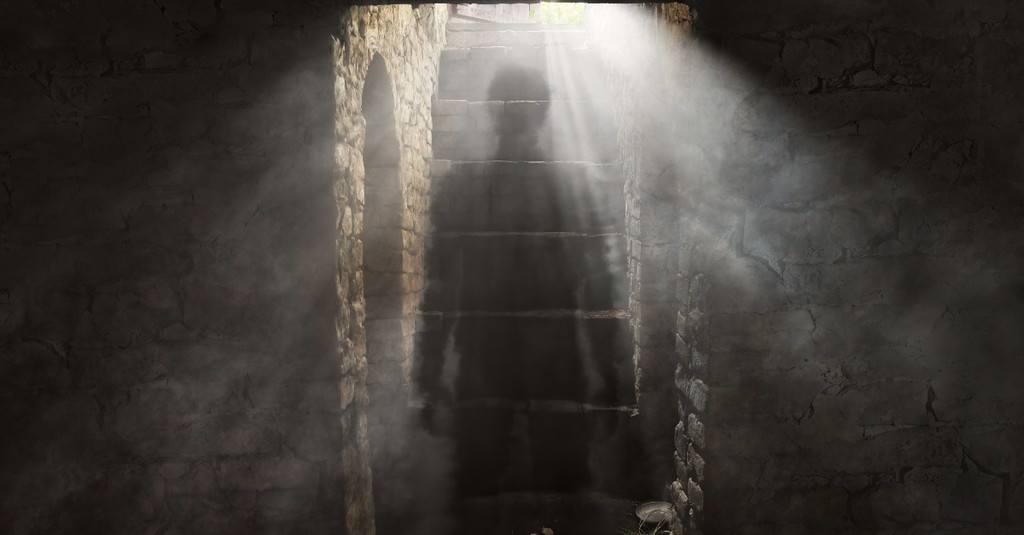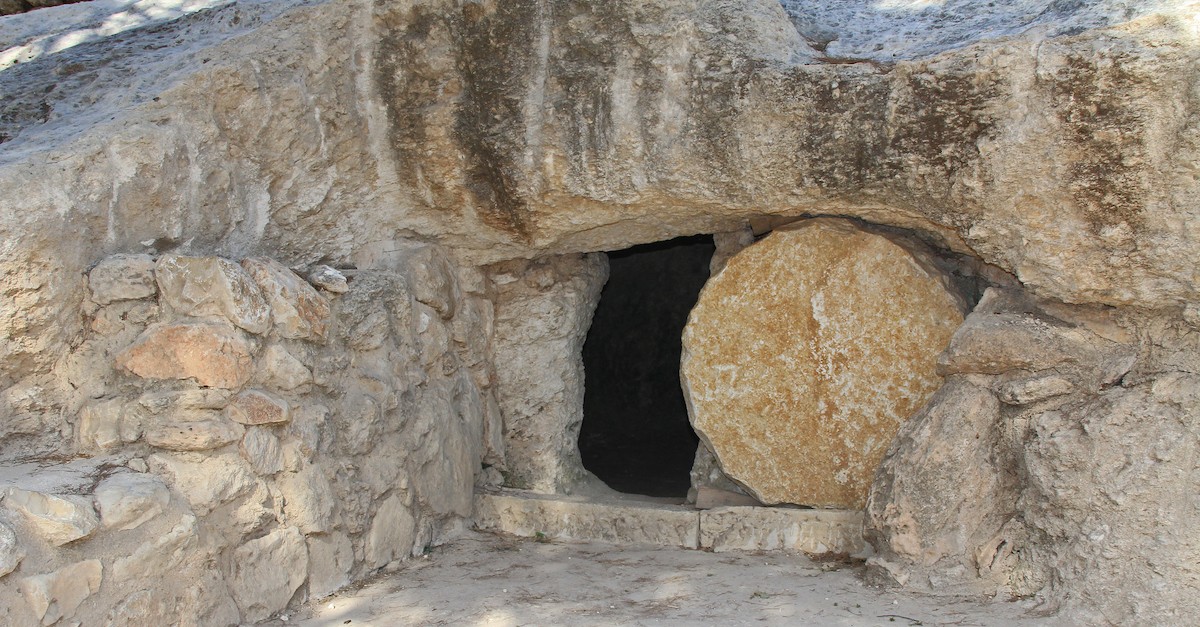
Many different characters and creatures appear in the pages of Scripture. The Bible references angels and demons, animals of every kind, shepherds, spies, giants, and kings. And… zombies?
This Easter, millions of Christians around the world will celebrate the glorious resurrection of Jesus Christ. However, the miraculous nature of Christ’s return from the dead and His emergence from the garden tomb have recently led some to wonder: could Jesus have been a zombie?
In truth, Jesus was not a zombie in the same sense that our media likes to portray them. His rotting corpse did not hobble around the streets of Jerusalem drooling, groaning, and looking to feast on human brains. However, resurrection is a key doctrine of the Christian faith and essential to our understanding of spiritual death and the eternal life that Christians will one day inherit by sharing in the resurrection of Jesus Christ.
Photo Credit: ©iStock/Getty Images Plus/Rastan

What Is a Zombie?
Pop culture has been fascinated with stories about zombies and the undead for decades, but what is a zombie exactly?
In books, television shows, video games, and movies, a zombie is often portrayed as a reanimated corpse that is capable of movement but not rational thought. As it continues to decompose, the archetypal zombie mindlessly feeds on its unsatiable appetite for human flesh, often in the form of human brains. Movies like George A. Romero’s Night of the Living Dead (1986), World War Z (2013), Zombieland (2009), and Shaun of the Dead (2004), as well as series like The Walking Dead (2010), have helped define the zombie sub-genre of horror and science fiction. Even Michael Jackson’s iconic “Thriller” music video has added to our cultural understanding of zombies.
Predating film and television, the fictional Dr. Frankenstein famously experimented on corporeal reanimation with his iconic monster in Mary Shelley’s Frankenstein (1818), and it was Bram Stoker who breathed life (no pun intended) into the undead vampire trope in his gothic horror Dracula (1897).
Of course, some have cited ties to West African witchcraft and Caribbean Voodoo as the inspiration for the attempted reanimation of dead things. In this context, demonic influences and dark spiritual forces are certainly at work and should be avoided by Christians. However, most on-screen, pop culture zombies are far removed from this influence and exist today as nothing more than fictional creatures, creepy and grotesque as they may be.
But are there zombies in the Bible?
In the traditional sense of the word, no. Zombies do not make an appearance in the Bible.
However, a few passages in Scripture do testify to the resurrection of individuals who were once dead (see 1 Kings 17:12-24; Matthew 9:18-26; John 11:1-44; Acts 20:9-12).
Matthew’s gospel also references a mostly unexplainable phenomenon, in which the tombs outside of Jerusalem were opened and “many bodies of the saints who had fallen asleep were raised; and coming out of the tombs after His (Jesus’) resurrection they entered the holy city and appeared to many.” (Matthew 27:52-53) Whether this was a literal instance of the dead being raised to life or a vision of the eventual resurrection of all saints to eternal glory as a result of Christ’s finished work on the cross, we do not know.
Other similar references in Scripture are understood to be figurative (Ezekiel 37:4-8), prophecies pointing to some form of plague or pestilence that effects human flesh (Zechariah 14:12-13), or references to the spiritual resurrection of the dead to eternal glory or judgment in the last days (Daniel 12:1-2; Revelation 20:5; 12-13).
When it comes to the question of whether the resurrected Jesus was a zombie or not, however, we must begin by answering, was Jesus actually dead?
Photo credit: ©Getty Images/studiodav

How Do We Know That Jesus Died?
In order for Jesus to have been a zombie in the traditional, pop culture understanding of the term, He would have had to die prior to His resurrection.
Why is this relevant?
It is relevant because many in the first century, particularly the enemies of Jesus and the emerging church, would have sought to publicly discredit and debunk the apostles’ testimony of the resurrection of Jesus Christ. Even today, it is not uncommon for those who dismiss the resurrection and downplay Jesus Christ as the Son of God to argue that Jesus never actually died. As the argument from some skeptics, critics, and atheists follows, if Jesus never died, His “resurrection” was nothing more than a hoax. And if Jesus never died, there was nothing special, supernatural, or miraculous about His “return”.
Of course, this matters because the resurrection of Jesus Christ is essential to the Christian faith. As the apostle Paul argued, “if Christ has not been raised, then our preaching is vain, your faith also is vain.” (1 Corinthians 15:14)
Therefore, in order for there to be a resurrection or even the possibility of Jesus returning from the dead, He first had to die.
So, what evidence do we have that Jesus actually died on the Friday before His heralded resurrection?
To start, by the time Jesus was nailed to the cross, He was already in critical condition as a result of the immense physical trauma and blood lost from the beatings, scourging, and crown of thorns suffered at the hands of the Romans (see Matthew 27:26-32; Mark 15:16-21; Luke 23:13-25;).
Forensic evidence, derived from historical accounts of Roman crucifixion and the testimony of eyewitnesses provided in the gospels, suggest that Jesus was severely dehydrated, in hypovolemic shock, and entering the early stages of cardiorespiratory and kidney failure as He was led to the cross. He was then nailed to a Roman cross, where He was sentenced to die (Matthew 27:33-49; Mark 15:22-36; Luke 23:33-45).
Even if Jesus had survived the cross and been taken down that evening, He would have required a team of trained medical physicians to care for His physical body. He also would have remained in intensive care for weeks, if not months.
Even with the help of modern medical technology, the chances of Jesus, who was marred beyond recognition, fully recovering from His wounds and walking around Judea mere days after He was nailed to a cross would have been improbable if not impossible.
Secondly, the apostle John, who was at the cross when Jesus died, observed that “one of the Roman soldiers pierced His side with a spear.” (John 19:34) This thrust, aimed at Jesus’ heart and lungs, would have been fatal to anyone still living. Given the organs pierced, it was not a wound someone could have recovered from. The spear, on top of everything else Jesus had already suffered, ensured that He was truly dead.
Third, by most historical accounts, Roman crucifixion was one of the slowest and most painful forms of execution ever conceived. Throughout the first century, the Romans had perfected the art of crucifixion. They were proficient and prolific at what they did. People did not survive Roman crucifixion very often, if at all. If the Romans wanted someone dead, they made sure that it happened. Therefore, if Jesus had survived crucifixion, the Romans would have had to have failed in their task. That is highly unlikely.
This leads to the fourth piece of evidence that Jesus actually died: the testimony of eyewitnesses. Christ’s death was seen and confirmed by those standing at the foot of the cross. This included Roman soldiers, Jewish leaders, followers of Jesus, and other civilians who were there (Luke 23:47-49). Both friends and enemies of Jesus testified to His death. This included those who mourned His passing and those who wanted Him dead.
The Pharisees, for example, had asked Pontius Pilate, the Roman governor, to hasten Jesus’ death by having His legs broken, resulting in swift asphyxiation. However, when the soldiers went to break Jesus’ legs, “they saw that He was already dead.” (John 19:31-33)
In summary, Roman soldiers skilled in the art of crucifixion concluded that Jesus Christ had died. A Roman soldier ensured this by putting a spear through Jesus’ heart and lungs. John the apostle, Jesus’ own mother, and the women at the foot of the cross (Matthew 27:55-56; Mark 15:40-41; Luke 23:49; ) also confirmed His death.
The Jewish leaders, who called for Jesus’ death, were also satisfied that Jesus had died. Only then would Joseph of Arimathea be granted permission to take the body of Jesus, wrap it in linen, and place it in a tomb that was guarded and sealed by a large, heavy stone (Matthew 27:57-60; Mark 15:42-47; Luke 23:50-56; John 19:38-42). The gospels also note the presence of Mary Magdalene and others who saw the body of Jesus being placed in the tomb (Mark 15:47).
Of course, after receiving news of Jesus’ reported resurrection, the Pharisees and chief priests swiftly paid off the soldiers at the tomb and instructed them to testify that it was actually the disciples of Jesus who “came by night and stole the body of Jesus while everyone was asleep.” (Matthew 28:11-15) This theory persists to this day and is often shared by those seeking to explain the missing body and deny the resurrection. However, while the Pharisees may have lied about the disappearance of Christ’s body, even they could not deny that there was a dead body in the tomb to begin with.
Therefore, despite claims to the contrary, there is enough credible recorded evidence for us to conclude that Jesus had died and was buried, as the gospels tell us (Matthew 27:50-51; Mark 15:37-47; Luke 23:46-56; John 19:30-42).
Photo credit: ©GettyImages/LindaJohnsonbaugh

Was the Resurrected Jesus a Zombie?
Since Jesus was dead, do the reports of His resurrection, therefore, support the theory that He was a zombie?
The simple answer to this question lies in the distinction between resurrection and reanimation.
Unlike most fictional zombies, when Jesus appeared in His resurrected form, His physical body did not emerge from the tomb as a putrid, decomposing corpse seeking human flesh to devour. Others did not run from Him or hold their nose when He stood before them (see Matthew 28:8-10; 16-20; Mark 16:9-20; Luke 24:13-53; John 20:14-21:25). Rather, the gospels record that Jesus was fully resurrected, fully healed, and fully alive.
Jesus was resurrected and alive, not just reanimated. This separates the biblical accounts of resurrection from most descriptions of contemporary zombies.
After His resurrection, Jesus appeared to His disciples (and others), conversed with them, ate with them, performed miracles, and even allowed others to touch His restored and resurrected body.
When the angels greeted the women who had arrived at the empty tomb, they also confirmed that Jesus was, in fact, alive. “Why do you seek the living One among the dead?” they asked. “He is not here, but He has risen.” (Luke 24:5-6; emphasis added)
Unlike a fictional zombie, the term death no longer applied to the risen Christ. “In Him was life, and the life was the light of men.” (John 1:4)
And unlike other biblical resurrections, where individuals were brought back to life by the power of the Holy Spirit, lived out the remainder of their lives, and eventually died a physical death (see 1 Kings 17:12-24; Matthew 9:18-26; John 11:1-44; Acts 20:9-12), the apostle Paul writes in his letter to the Romans, “we know that Christ, being raised from the dead, will never die again; death no longer has dominion over Him.” (Romans 6:9; emphasis added)
Jesus’ physical body had been resurrected and even perfected to its glorious state. “I am the Living One,” the risen Christ would proclaim in the book of Revelation, “I was dead, and now look, am alive for ever and ever!” (Revelation 1:18)
Photo credit: ©GettyImages/KatarzynaBialasiewicz
.1200w.tn.jpg)
What Is the Significance of the Biblical Resurrection?
While the kind of zombies we see in movies and television shows may not have a presence in the pages of Scripture, the Bible does have a lot to say on the topic of death and resurrection.
Even in the Old Testament, God used the language of death to describe the spiritual effects of sin. As far back as the Garden of Eden, God warned that the cost of sin and disobedience would be death, a death that is both physical and spiritual (Genesis 2:15-17).
Consequentially, from Adam, all are “born in iniquity” (Psalms 51:5), and “all have sinned and fallen short of the glory of God.” (Romans 3:23; emphasis added)
The New Testament writers reiterate what the Law of Moses and Old Testament prophets always affirmed: “the wages of sin is death” (Romans 6:23; see also Ezekiel 18:20); and “when sin is accomplished, it brings forth death.” (James 1:15; emphasis added)
Most people believe that they are mostly good, even if they make mistakes. The Bible, however, makes clear that “none are righteous, no not one” (Romans 3:10-12; Psalms 14:1-3; 53:1-3), and “those who are in the flesh cannot please God.” (Romans 8:8) Flesh, in this context, refers to our corrupt, sinful nature. To God, our righteousness and good works are like “filthy rags” (Isaiah 64:6).
The language of the Bible does not mince words on the effects of sin: we are all “dead in our trespasses and sins” (Ephesians 2:1; emphasis added)
This is the closest parallel to sinful mankind being the spiritual version of the walking dead.
Our condition also magnifies Christ’s eventual sacrifice. His was not merely a rescue mission or errand of mercy. He came to revive, resuscitate, and resurrect that which was dead (see Ezekiel 27:4-5). Jesus said, “the thief comes only to steal and kill and destroy; I came that they may have life, and have it abundantly.” (John 10:10; emphasis added)
Thanks to Christ’s death and resurrection, death is no longer the final outcome for those who repent, believe, and put their faith in Jesus (see Isaiah 26:19-20).
Yes, we will all still die a physical death one day. However, Jesus promised that “as Moses lifted up the serpent in the wilderness, even so must the Son of Man be lifted up; so that whoever believes will in Him have eternal life. For God so loved the world, that He gave His only begotten Son, that whoever believes in Him shall not perish, but have eternal life.” (John 3:14-16) For, “He (God) made Him (Jesus) who knew no sin to be sin on our behalf, so that we might become the righteousness of God in Him.” (2 Corinthians 5:21; emphasis added)
Furthermore, the Bible teaches that “God, being rich in mercy, because of His great love with which He loved us, even when we were dead in our transgressions, made us alive together with Christ (by grace you have been saved), and raised us up with Him, and seated us with Him in the heavenly places in Christ Jesus.” (Ephesians 2:1-6; emphasis added)
Accordingly, those who put their faith in Jesus Christ will also share in the glory of His resurrection, becoming “like Him.” (see 1 John 3:2) One day, we will experience a similar resurrection of our physical bodies, putting aside what is perishable for that which is imperishable and immortal in Jesus Christ (see 1 Corinthians 15:50-56)
The apostle Paul also writes “We have been buried with Him through baptism into death, so that as Christ was raised from the dead through the glory of the Father, so we too might walk in newness of life. For if we have become united with Him in the likeness of His death, certainly we shall also be in the likeness of His resurrection, knowing this, that our old self was crucified with Him, in order that our body of sin might be done away with, so that we would no longer be slaves to sin; for he who has died is freed from sin.” (Romans 6:4-6; see also Galatians 2:20)
It is the saving work of Christ’s resurrection that brings new life to those who were formerly dead in sin. “Therefore, if anyone is in Christ, he is a new creature; the old things passed away; behold, new things have come.” (2 Corinthians 5:17)
In many ways, the resurrection of Jesus Christ and the eternal life offered to all who put their faith in Him is the complete opposite of what we see in most zombie movies. Instead, the glorious theme of Easter and Christianity is that Jesus Christ, who is “the resurrection and the life” (John 11:25), triumphs over sin and death.
As it is written, “’Death is swallowed up in victory. O death, where is your victory? O death, where is your sting?’ The sting of death is sin, and the power of sin is the law; but thanks be to God, who gives us the victory through our Lord Jesus Christ.” (1 Corinthians 15:50-56)
Amen!
Additional Resources:
“Are There Zombies in the Bible?”
“Bible Verses About Zombies”
“Zombies and Vampires and Ghosts, Oh My!”
“When Zombies Roamed the Streets of Jerusalem”
“What Should Christians Have to Say About Zombie Movies?”
Photo credit: ©Lightstock

Originally published Monday, 07 April 2025.
